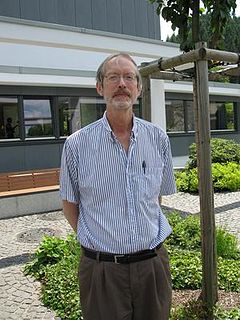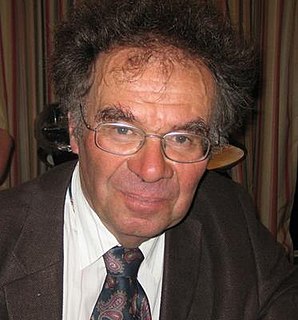
John Torrence Tate Jr. is an American mathematician, distinguished for many fundamental contributions in algebraic number theory, arithmetic geometry and related areas in algebraic geometry. He is professor emeritus at Harvard University. He was awarded the Abel Prize in 2010.
In topology, a branch of mathematics, intersection homology is an analogue of singular homology especially well-suited for the study of singular spaces, discovered by Mark Goresky and Robert MacPherson in the fall of 1974 and developed by them over the next few years.
The mathematical term perverse sheaves refers to a certain abelian category associated to a topological space X, which may be a real or complex manifold, or a more general topologically stratified space, usually singular. This concept was introduced in the thesis of Zoghman Mebkhout, gaining more popularity after the (independent) work of Joseph Bernstein, Alexander Beilinson, and Pierre Deligne (1982) as a formalisation of the Riemann-Hilbert correspondence, which related the topology of singular spaces and the algebraic theory of differential equations. It was clear from the outset that perverse sheaves are fundamental mathematical objects at the crossroads of algebraic geometry, topology, analysis and differential equations. They also play an important role in number theory, algebra, and representation theory. Note that the properties characterizing perverse sheaves already appeared in the 75's paper of Kashiwara on the constructibility of solutions of holonomic D-modules.
In mathematics, equivariant cohomology is a cohomology theory from algebraic topology which applies to topological spaces with a group action. It can be viewed as a common generalization of group cohomology and an ordinary cohomology theory. Specifically, the equivariant cohomology ring of a space X with action of a topological group G is defined as the ordinary cohomology ring with coefficient ring of the homotopy quotient :
This is a glossary of arithmetic and diophantine geometry in mathematics, areas growing out of the traditional study of Diophantine equations to encompass large parts of number theory and algebraic geometry. Much of the theory is in the form of proposed conjectures, which can be related at various levels of generality.
In algebraic geometry, the Chow groups of an algebraic variety over any field are algebro-geometric analogs of the homology of a topological space. The elements of the Chow group are formed out of subvarieties in a similar way to how simplicial or cellular homology groups are formed out of subcomplexes. When the variety is smooth, the Chow groups can be interpreted as cohomology groups and have a multiplication called the intersection product. The Chow groups carry rich information about an algebraic variety, and they are correspondingly hard to compute in general.

Robert Duncan MacPherson is an American mathematician at the Institute for Advanced Study and Princeton University. He is best known for the invention of intersection homology with Mark Goresky, whose thesis he directed at Brown University. MacPherson previously taught at Brown University, the University of Paris, and the Massachusetts Institute of Technology. In 1983 he gave a plenary address at the International Congress of Mathematicians in Warsaw.
Robert Mark Goresky is a Canadian mathematician who invented intersection homology with Robert MacPherson.
In mathematics, L2 cohomology is a cohomology theory for smooth non-compact manifolds M with Riemannian metric. It is defined in the same way as de Rham cohomology except that one uses square-integrable differential forms. The notion of square-integrability makes sense because the metric on M gives rise to a norm on differential forms and a volume form.
In algebraic geometry, a Schubert variety is a certain subvariety of a Grassmannian, usually with singular points. Like a Grassmannian, it is a kind of moduli space, whose points correspond to certain kinds of subspaces V, specified using linear algebra, inside a fixed vector subspace W. Here W may be a vector space over an arbitrary field, though most commonly over the complex numbers.
In mathematics, the Springer representations are certain representations of the Weyl group W associated to unipotent conjugacy classes of a semisimple algebraic group G. There is another parameter involved, a representation of a certain finite group A(u) canonically determined by the unipotent conjugacy class. To each pair consisting of a unipotent element u of G and an irreducible representation φ of A(u), one can associate either an irreducible representation of the Weyl group, or 0. The association
In mathematics and specifically in topology, rational homotopy theory is a simplified version of homotopy theory for topological spaces, in which all torsion in the homotopy groups is ignored. It was founded by Dennis Sullivan (1977) and Daniel Quillen (1969). This simplification of homotopy theory makes calculations much easier.
In algebraic geometry, the Mumford–Tate groupMT(F) constructed from a Hodge structure F is a certain algebraic group G. When F is given by a rational representation of an algebraic torus, the definition of G is as the Zariski closure of the image in the representation of the circle group, over the rational numbers. Mumford (1966) introduced Mumford–Tate groups over the complex numbers under the name of Hodge groups. Serre (1967) introduced the p-adic analogue of Mumford's construction for Hodge–Tate modules, using the work of Tate (1967) on p-divisible groups, and named them Mumford–Tate groups.
Edward Robert Kottwitz is an American mathematician.
In algebraic geometry, a torus action on an algebraic variety is a group action of an algebraic torus on the variety. A variety equipped with an action of a torus T is called a T-variety. In differential geometry, one considers an action of a real or complex torus on a manifold.
In mathematics, given an action of a group scheme G on a scheme X over a base scheme S, an equivariant sheafF on X is a sheaf of -modules together with the isomorphism of -modules
In mathematics, Koszul duality, named after the French mathematician Jean-Louis Koszul, is any of various kinds of dualities found in representation theory of Lie algebras, abstract algebras as well as topology. The prototype example, due to Joseph Bernstein, Israel Gelfand, and Sergei Gelfand, is the rough duality between the derived category of a symmetric algebra and that of an exterior algebra. The importance of the notion rests on the suspicion that Koszul duality seems quite ubiquitous in nature.
In differential geometry, the localization formula states: for an equivariantly closed equivariant differential form on an orbifold M with a torus action and for a sufficient small in the Lie algebra of the torus T,
Tara Suzanne Holm is a mathematician at Cornell University specializing in algebraic geometry and symplectic geometry.

Günter Harder is a German mathematician, specializing in arithmetic geometry and number theory.





